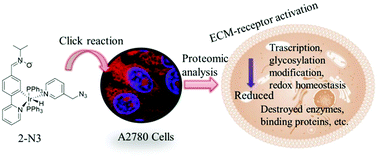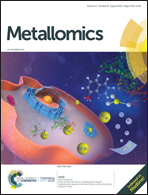Imaging and proteomic study of a clickable iridium complex†
Abstract
Iridium complexes have recently attracted increasing interest in developing metallodrugs. Herein, we have synthesized and characterized a clickable iridium hydride complex 2-N3. The cytotoxity and production of reactive oxygen species study in A2780 cancer cells indicated a potent anticancer activity of 2-N3. The ICP-MS analysis and the cellular imaging via Cu(I) catalyzed azide–alkyne cycloaddition suggested the accumulation of 2-N3 in the nucleus and cytoplasm. Further label-free quantitative proteomic analysis indicated that the ECM–receptor interaction pathway was activated by 2-N3. The analysis of down-regulated proteins suggested that 2-N3 affected cellular DNA transcription, post-translational glycosyl modification, and redox homeostasis. Besides, 2-N3 also damaged several crucial proteins and enzymes in the mitochondria and nucleus, leading to the disorder of the cellular processes. Our results provide a new approach to mechanism studies of metallodrugs combining click chemistry and proteomic analysis.



 Please wait while we load your content...
Please wait while we load your content...